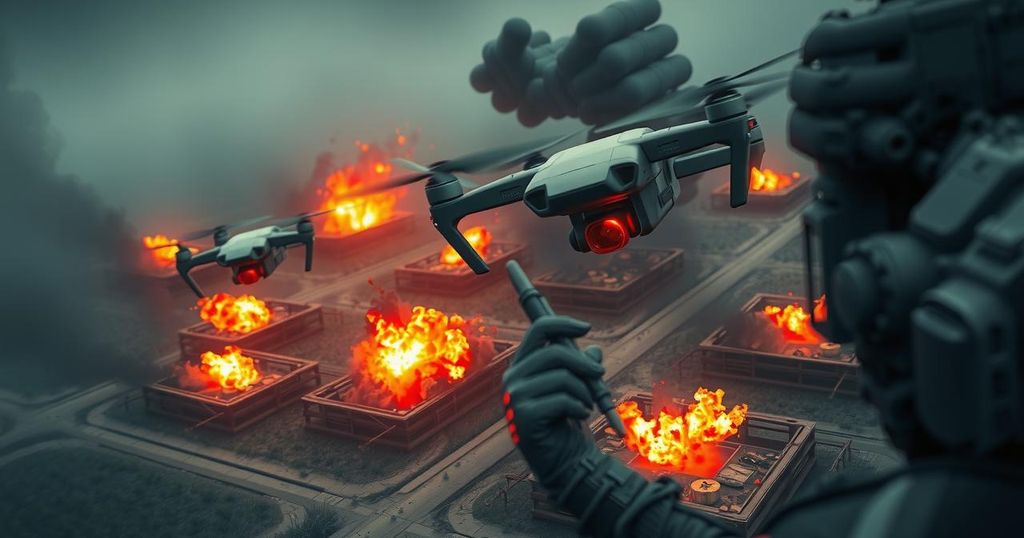Ukraine Drone Attack Destroys Russian Aircraft Ahead of Peace Talks

Ukraine’s recent drone attack reportedly destroyed over 40 Russian planes deep in Russia, coinciding with imminent peace talks in Istanbul. The operation, overseen by President Zelensky, involved complex strategies like smuggling drones. With claims of extensive damage to Russian air capabilities, tensions remain high as military actions and diplomatic efforts advance in tandem.
On Sunday, Ukraine’s Security Service announced a significant drone attack that obliterated over 40 Russian aircraft, marking a notable escalation in the ongoing conflict. This strike took place deep within Russian territory, coinciding with renewed peace discussions set for Istanbul just hours later. While this attack sends a clear message, it also raises questions about the future of negotiations between the two nations.
A military source, speaking under the condition of anonymity to protect operational details, revealed that the meticulously planned operation dated back more than a year and a half and received personal oversight from Ukrainian President Volodymyr Zelensky. In his evening address, Zelensky stated that 117 drones were deployed in the attack, which was launched from a location disturbingly close to the local FSB, Russia’s intelligence agency.
According to the military source, the operation involved an intricate method of smuggling first-person view (FPV) drones into Russia, where they were concealed in mobile wooden homes. The source elaborated that upon reaching a critical moment, the drones were launched after their concealment was remotely lifted. Footage circulating online reportedly shows drones taking off from inside containers, hinting at the surprising nature of the assault.
The drone attack successfully targeted various military airfields Sunday afternoon, apparently damaging A-50, Tu-95, and Tu-22M aircraft. Each of these models has played a role in facilitating assaults against Ukraine in the ongoing conflict. Ukrainian officials claim this operation, dubbed “Web,” considerably weakened Russian air capabilities, destroying approximately 34 percent of their missile-carrier fleet, with damage estimates reaching around $7 billion. These numbers, however, have yet to be independently verified.
In response, Russia’s Defense Ministry confirmed ‘aircraft damage’ alongside reported fires at airbases far in the Irkutsk region, reaching over 4,000 kilometers from Ukraine. Additionally, they cited instances of repelled attacks in other locations further from the front lines, indicating an ongoing struggle to secure their own airspace.
The United States has been closely monitoring this situation. US Defense Secretary Pete Hegseth was informed about the drone strike while visiting a military base, and a source revealed that the US had not been alerted about Ukraine’s planned endeavor. This development signified a new level of sophistication on Ukraine’s part that US officials had not anticipated before.
Adding to the recent chaos, Russia’s investigative body reported explosions leading to collapsed bridges and train derailments in western Russia, resulting in seven fatalities and dozens of injuries. Interestingly, the reasons behind these blasts remained hazy when officials later omitted references to “explosions” from public communications.
Slated for talks starting Monday, President Zelensky confirmed Ukraine’s delegation led by Defense Minister Rustem Umerov will be present in Istanbul. He emphasized Ukraine’s commitment to safeguarding its sovereignty amid ongoing turmoil. The Kremlin is yet to deliver a promised memorandum outlining its position on resolving the conflict, a prerequisite Ankara had pushed for prior to the discussions.
On the same day, Russia unleashed its largest drone strike, launching 472 drones against Ukraine, while also firing missiles, according to Ukraine’s air force. Reports indicated that this assault claimed the lives of at least 12 Ukrainian soldiers during a missile strike on an army training unit, further intensifying the toll of ongoing hostilities.
In light of these events, Commander Mykhailo Drapatyi submitted his resignation following the assault on the training unit. He was well-respected for his leadership in Ukraine’s counteroffensive efforts, which had been significant in reclaiming territory along the eastern front.
With an active 1,000-kilometer front line and Russian reconnaissance drones persistently seeking targets, Ukrainian forces are reportedly facing mounting challenges. As the situation unfolds, the balance between military operations and diplomatic engagements remains delicate at best.
In sum, the drone attack by Ukraine on Russian territory marks a significant moment in the ongoing conflict, demonstrating both strategic complexity and operational coordination. With impending peace talks in Istanbul, the atmosphere is tense as Ukraine asserts its military capabilities while pushing for negotiations. Meanwhile, the situation on the front lines grows increasingly precarious as both nations navigate their military engagements and political negotiations end up intertwining more tightly than ever.
Original Source: www.arabnews.pk








